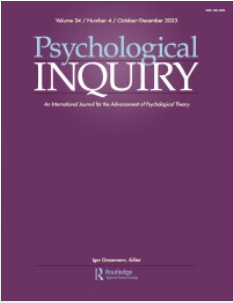Implicit Bias as Automatic Behavior
IF 4.1
2区 心理学
Q1 PSYCHOLOGY, MULTIDISCIPLINARY
引用次数: 1
Abstract
Researchers interested in implicit bias agree that no one agrees what implicit bias is. Gawronski, Ledgerwood, and Eastwick (this issue) join a spate of scholars calling for better conceptual clarity around what it means for a construct or a measure to be implicit (Corneille & H€ utter, 2020; Fazio, Granados Samatoa, Boggs, & Ladanyi, 2022; Schmader, Dennehy, & Baron, 2022; Van Dessel et al., 2020). Some argue we should do away with the term entirely (Corneille & H€ utter, 2020), and others argue that authors simply need to do a better job defining how they are idiosyncratically using the term each time they use it (Greenwald & Lai, 2020). In their target article, Gawronski et al. argue for a fundamental redefinition of what it means for bias to be implicit. More specifically, they argue that implicit bias (IB) and bias on implicit measures (BIM) are conceptually and empirically distinct, and that BIM (defined as “effects of social category membership on behavioral responses captured by measurement instruments conventionally describe as implicit”) should not be treated as an instance of IB (defined as “behavioral responses influenced by social category cues when respondents are unaware of the effect of social category cues on their behavioral responses”). We agree that the time has come for our definition of implicit to be revamped in light of new findings. In fact, it is past time; we co-chaired a symposium titled “What is implicit about implicit attitudes?” at the Society for Personality and Social Psychology’s annual meeting in 2009, more than a decade ago. And we applaud the authors of the target article for taking a bold step toward making a change. Further, we agree with them that bias is best defined as a behavioral phenomenon rather than a latent mental construct. This is not a statement we make lightly; it has required some serious scholarly contemplation of the current state of the literature and some serious non-scholarly contemplation of our own egos to reach this conclusion. For some time now we, like most others, have described implicit bias as something that people have–e.g., participants have an implicit bias favoring one novel individual over another (Ratliff & Nosek, 2011), have an implicit preference favoring White over Black Americans (Chen & Ratliff, 2018), or have an implicit positive or negative attitude toward feminists (Redford, Howell, Meijs, & Ratliff, 2018). Many of us are quite invested in this way of thinking. And change is hard! But we recognize that we gain a lot by taking this more functional approach to bias. Most notably, a functional approach allows researchers to circumvent the perplexing situation of using the same name for construct and measure. Further, many of us working in this area are doing so because we hope to provide insights through which people can change their behavior in order to reduce inequality on real life issues that matter. Given that the problem of bias is a behavioral problem (De Houwer, 2019), it makes sense to define bias in behavioral terms. So let us agree to define bias as the influence of social category cues on behavioral responses. But we are still left, however, with the problem of what makes bias implicit. To that end, we would like to raise two concerns about the target article. First, if the authors had proposed that BIM should not necessarily be treated as an instance of IB, we would concur; but we disagree with the strong language implying that BIM should never be considered an instance of IB; “does not equal” is not the same as “is orthogonal to.” Second, we do not agree that awareness (which the original authors use interchangeably with consciousness) is the only or best factor by which to distinguish implicit from explicit bias. Consciousness is messy business, and it is nearly impossible to delineate whether any given effect is unconscious or conscious as most, maybe all, have aspects of both. We would instead argue for distinguishing between implicit and explicit bias based on features of automaticity (Moors & De Houwer, 2006).内隐偏见是一种自动行为
对隐性偏见感兴趣的研究人员一致认为,没有人同意什么是隐性偏见,和Eastwick(本期)加入了一系列学者的行列,呼吁更好地从概念上澄清隐含的结构或措施的含义(Cornelle&H€utter,2020;Fazio、Granados-Samatoa、Boggs和Ladanyi,2022;Schmader、Dennehy和Baron,2022;Van Dessel等人,2020)。一些人认为我们应该完全废除这个词(Cornelle&H€utter,2020),另一些人则认为,作者只需要更好地定义他们每次使用这个词时是如何独特地使用这个词的(Greenwald&Lai,2020)。在他们的目标文章中,Gawronski等人主张从根本上重新定义隐性偏见的含义。更具体地说,他们认为内隐偏见(IB)和对内隐测量的偏见(BIM)在概念和经验上是不同的,BIM(定义为“社会类别成员资格对测量仪器捕捉到的行为反应的影响,通常被描述为隐含的”)不应被视为IB的一个例子(定义为:“当受访者不知道社会类别线索对其行为反应的影响时,受社会类别线索影响的行为反应”)。我们一致认为,现在是时候根据新的发现来修改我们对隐性的定义了。事实上,时间已经过去了;在十多年前的2009年人格与社会心理学学会年会上,我们共同主持了一个题为“内隐态度的内隐是什么?”的研讨会。我们赞扬目标文章的作者在做出改变方面迈出了大胆的一步。此外,我们同意他们的观点,即偏见最好被定义为一种行为现象,而不是一种潜在的心理结构。这不是我们轻率的声明;要得出这个结论,需要对文学的现状进行一些严肃的学术思考,也需要对我们自己的自我进行一些严肃而非学术的思考。一段时间以来,我们和大多数其他人一样,将内隐偏见描述为人们所具有的东西——例如,参与者对一个小说个体比对另一个有内隐偏见(Ratliff&Nosek,2011),对白人比对美国黑人有内隐偏好(Chen和Ratliff,2018),或者对女权主义者有隐含的积极或消极态度(Redford,Howell,Meijs,&Ratliff,2018)。我们中的许多人都对这种思维方式非常投入。改变很难!但我们认识到,通过采取这种更具功能性的方法来解决偏见,我们收获了很多。最值得注意的是,功能方法使研究人员能够避免使用相同名称进行构建和测量的令人困惑的情况。此外,我们许多在这一领域工作的人之所以这样做,是因为我们希望提供见解,让人们能够改变自己的行为,以减少现实生活中重要问题上的不平等。鉴于偏见问题是一个行为问题(De Houwer,2019),用行为术语来定义偏见是有意义的。因此,让我们同意将偏见定义为社会类别线索对行为反应的影响。然而,我们仍然面临着偏见隐含的问题。为此,我们想对目标文章提出两个关切。首先,如果作者提出BIM不一定应被视为IB的一个例子,我们会同意;但我们不同意强烈的语言暗示BIM永远不应该被视为IB的一个例子;第二,我们不同意意识(原作者可与意识互换使用)是区分隐性偏见和显性偏见的唯一或最佳因素。意识是一件混乱的事情,几乎不可能描述任何给定的效果是无意识的还是有意识的,因为大多数,也许所有,都有这两者的方面。相反,我们主张基于自动性的特征来区分内隐和外显偏见(Moors&De Houwer,2006)。
本文章由计算机程序翻译,如有差异,请以英文原文为准。
求助全文
约1分钟内获得全文
求助全文
来源期刊

Psychological Inquiry
PSYCHOLOGY, MULTIDISCIPLINARY-
CiteScore
10.30
自引率
1.10%
发文量
31
期刊介绍:
Psychological Inquiry serves as an international journal dedicated to the advancement of psychological theory. Each edition features an extensive target article exploring a controversial or provocative topic, accompanied by peer commentaries and a response from the target author(s). Proposals for target articles must be submitted using the Target Article Proposal Form, and only approved proposals undergo peer review by at least three reviewers. Authors are invited to submit their full articles after the proposal has received approval from the Editor.
 求助内容:
求助内容: 应助结果提醒方式:
应助结果提醒方式:


